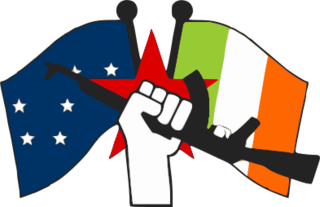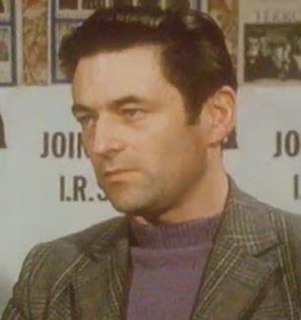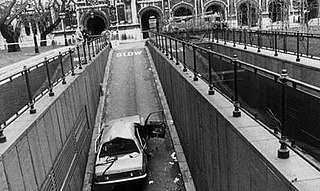
The Irish National Liberation Army is an Irish republican socialist paramilitary group formed on 10 December 1974, during the 30-year period of conflict known as "the Troubles". The group seeks to remove Northern Ireland from the United Kingdom and create a socialist republic encompassing all of Ireland. With membership estimated at 80–100 at their peak, it is the paramilitary wing of the Irish Republican Socialist Party (IRSP).

Seamus Costello was a leader of Official Sinn Féin and the Official Irish Republican Army and latterly of the Irish Republican Socialist Party (IRSP) and the Irish National Liberation Army (INLA).
The Irish Republican Socialist Party or IRSP is a Marxist-Leninist and republican party in Ireland. It is often referred to as the "political wing" of the Irish National Liberation Army (INLA) paramilitary group. It was founded in 1974, during the Troubles, by former members of the Workers' Party of Ireland, but claims the legacy of the Irish Socialist Republican Party of 1896–1904.

The Irish People's Liberation Organisation was a small Irish socialist republican paramilitary organisation formed in 1986 by disaffected and expelled members of the Irish National Liberation Army (INLA), whose factions coalesced in the aftermath of the supergrass trials. It developed a reputation for intra-republican and sectarian violence and criminality, before being forcibly disbanded by the Provisional Irish Republican Army (IRA) in 1992.
Jimmy Brown was a Belfast member of the Official IRA, then Irish Republican Socialist Party (IRSP) and the Irish National Liberation Army (INLA), and latterly of the Irish People's Liberation Organisation (IPLO).
Samuel Ward was the leader of the Irish People's Liberation Organisation's Belfast Brigade. The IPLO was made up of ex-members of the Irish National Liberation Army. Following its split from and feud with the INLA, the IPLO split into two factions, with Ward running one.
Gerard Steenson was an Irish republican paramilitary combatant in Northern Ireland.
Henry Kirkpatrick is a former Irish National Liberation Army member turned informer against other members of the INLA.
Patsy O'Hara was an Irish republican hunger striker and member of the Irish National Liberation Army (INLA).
Hugh Torney was an Irish National Liberation Army (INLA) paramilitary leader best known for his activities on behalf of the INLA and Irish Republican Socialist Party (IRSP) in a feud with the Irish People's Liberation Organisation (IPLO), a grouping composed of disgruntled former INLA members, in the mid-1980s.
William "Billy" McMillen, aka Liam McMillen, was an Irish republican activist and an officer of the Official Irish Republican Army (OIRA) from Belfast, Northern Ireland. He was killed in 1975, in a feud with the Irish National Liberation Army (INLA).

Christopher "Crip" McWilliams was a member of both the Irish People's Liberation Organisation (IPLO) and the Irish National Liberation Army (INLA) during the Troubles in Northern Ireland. He was convicted of the murder of Loyalist Volunteer Force (LVF) leader Billy Wright, who was shot by an INLA unit led by McWilliams inside the Maze Prison.
This is a timeline of actions by the Irish National Liberation Army (INLA), an Irish republican socialist paramilitary group. Most of these actions took place as part of its 1975–1998 campaign during "the Troubles" in Northern Ireland. The INLA did not start claiming responsibility for its actions under the INLA name until January 1976 at which point they had already killed 12 people, before then they used the names People's Liberation Army (PLA) and People's Republican Army (PRA) to claim its attacks.
The 1994 Shankill Road killings took place on 16 June 1994 when the Irish National Liberation Army (INLA) shot dead three Ulster Volunteer Force (UVF) members – high-ranking member of the UVF Belfast Brigade staff Trevor King and two other UVF members, Colin Craig and David Hamilton – on the Shankill Road in Belfast, close to the UVF headquarters. The following day, the UVF launched two retaliatory attacks. In the first, UVF members shot dead a Catholic civilian taxi driver in Carrickfergus. In the second, they shot dead two Protestant civilians in Newtownabbey, who they believed were Catholics. The Loughinisland massacre, two days later, is believed to have been a further retaliation.
The Night of the Long Knives is a name given to the night of 31 October 1992 in Belfast, when the Provisional IRA's Belfast Brigade launched an operation to wipe out the IPLO Belfast Brigade, who most Irish republicans in the city felt were becoming an embarrassment to Irish republicanism due to their involvement in drug dealing, criminality and internal republican feuds.

On 30 March 1979, Airey Neave, British Shadow Secretary of State for Northern Ireland, was assassinated by the Irish National Liberation Army with a bomb fixed under his car. The bomb detonated in the car park of the Palace of Westminster in London and mortally wounded Neave, who died shortly after being admitted to hospital.
The Central Bar bombing was a bomb attack on a pub in the town of Gilford near Portadown in County Down in Northern Ireland on 31 December 1975. The attack was carried out by members of the Irish National Liberation Army (INLA) using the covername "People's Republican Army". Three Protestant civilians were killed in the bombing.
The Official IRA's Belfast Brigade was founded in December 1969 after the Official IRA itself emerged in December 1969, shortly after the beginning of the Troubles, when the Irish Republican Army split into two factions. The other was the Provisional IRA. The "Officials" were Marxist-Leninists and worked to form a united front with other Irish communist groups, named the Irish National Liberation Front (NLF). The Brigade like the pre-split IRA brigade before the split had three battalions, one in West Belfast, one in North Belfast and the third in East Belfast. The Belfast Brigade was involved in most of the biggest early confrontations of the conflict like the Falls Curfew in 1970, the battles that followed after the introduction of Internment without trial in 1971 and Volunteers joined forces with the Provisional brigade to fight the British Army and UVF during the Battle at Springmartin in 1972. The first Commanding Officer (CO) of the brigade was veteran Billy McMillen who fought during the IRA Border Campaign. Shortly after the death of Official IRA Belfast "Staff Captain" Joe McCann in April 1972, the battalion structure of the brigade was done away with and command centralized under McMillen.

The Irish National Liberation Army Belfast Brigade was the main brigade area of the Irish National Liberation Army (INLA). The other Brigade areas were in Derry City, south County Londonderry and County Armagh, with smaller units in Newry, east and west County Tyrone and south County Fermanagh.
Martin "Rook" O'Prey was an Irish republican and a Volunteer in both the Irish republican & Revolutionary socialist paramilitaries, first the Irish National Liberation Army (INLA) and later the Irish People's Liberation Organisation (IPLO). He was killed by Ulster Loyalist paramilitaries from the Ulster Volunteer Force (UVF) in August 1991.






